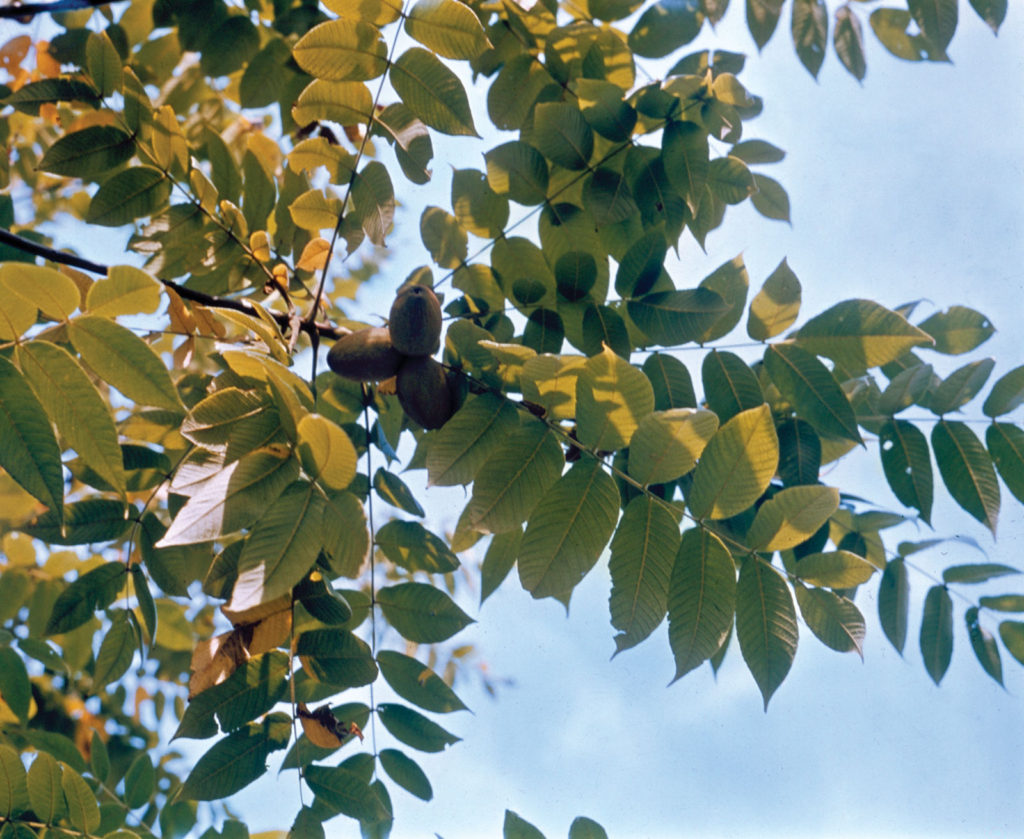Butternut trees are a native species to Eastern Canada, and grow in Southern Ontario, Quebec, and New Brunswick. They often grow along fences, the edges of forests, and open fields as they require sunlight to grow and bloom. It produces an edible nut for small mammals, gorgeous flowers, and unique wood and bark.
Butternut trees are classified as an Endangered Species in Ontario, meaning they are facing extinction in the province. This means that they require special consideration when they are located on properties where work is being carried out. Identifying any potential butternut trees on your property is essential for following provincial law and the first step before any work may be done on your property.
What do Butternut Trees Look Like?
Butternut trees can be identified first by their leaves, which are compound and made up of 11 to 17 leaflets, each nine to 15 centimetres long. They are arranged in a feather-like pattern.
Butternut trees also produce a large nut with a single seed, surrounded by light green, sticky, fuzzy husk. The buds are tan-coloured and hairy. In the spring, the buds are arranged alternately along the twig and two above each leaf.
The bark on younger trees is smooth and grey, while older trees have narrow, dark fissures and wide flat-topped ridges.
Butternut trees are often confused with similar species, such as the black walnut or butternut hybrids. Butternuts and Black Walnuts are very similar species, with some key differences in the bark, leaflets, and nuts. These small differences will be difficult for a layperson to recognize, which is why it’s important (and required by the provincial government) to have a Certified Butternut Health Assessor identify your Butternut trees.
What are Threats to Butternut Trees in Ontario?
Butternut trees are threatened primarily by butternut canker, a terrible disease that affects Butternuts across Canada. This fungal disease acts quickly and can kill a Butternut in as little as a few years. Butternut canker has devastated populations across Ontario, with as many as one third of trees in Ontario already succumbing. It spreads by spores in the wind and rain, making it particularly difficult to prevent.
Butternut canker can be identified by large, black cankers that appear on the bark around the trunk of the tree. These cankers ooze black liquid and continue to grow. They encircle branches and stems to cut off water flow and nutrients, causing those branches to die.
Butternut canker first affects the uppermost branches, so it can be difficult to diagnose early on. By the time it is visible from the ground, the tree is often badly affected.
There are some symptoms of butternut canker to look for on your trees:
- Leaves and branches dying in sunlit portions of the crown
- Sunken, elongated, diamond-shaped cankers in dark brown or black
- Branches sprouting below cankers
- In spring, thin black fluid oozes from the bark and cankers
- In summer, fall, and winter, this fluid dries into a sooty patch on the bark
Think You Have a Butternut on Your Property?
If you think you have a Butternut tree on your property, you should contact a Certified Butternut Health Assessor to identify it professionally. There are restrictions about what can and cannot be done to a Butternut in Ontario due to its endangered status.
If you have a confirmed Butternut on your property, you need to get an expert opinion before you prune hazardous branches so as to not damage the tree. If it is unhealthy or dead, it must be assessed as “non-retainable” by a designated Butternut Health Assessor before it can be cut down.
If you need to perform work on your property near the tree, you must ensure that the tree is protected from accidents and will be able to flourish when work is over. A Butternut Health Assessor can create a Tree Protection Plan specific to your property to ensure this follows all provincial regulations.
Lastly, if you want to remove a healthy Butternut tree from your property, there are recovery programs you can participate in. You cannot remove a healthy confirmed Butternut from your property without applying for a permit under the Endangered Species Act and participating in a Butternut recovery program.
Butternut Health Assessors
The Ministry of Natural Resources designated Butternut Health Assessors and these professionals are able to help you from beginning to end in managing your Butternuts on your property.
If you think you may have a Butternut tree on your property, contact P & A for a certified Butternut Health Assessment. We can identify if it is a Butternut, provide recommendations for care and management, and help you attain the right permits for any work you may want to carry out on your property.
Learn more from the Government of Ontario
